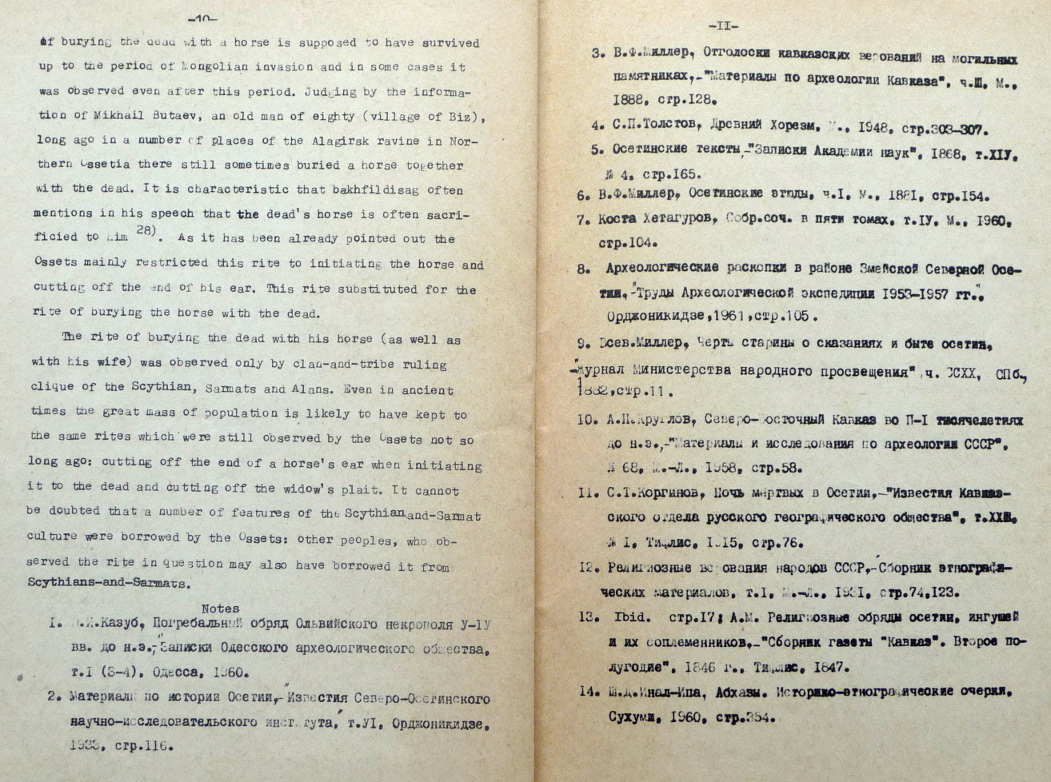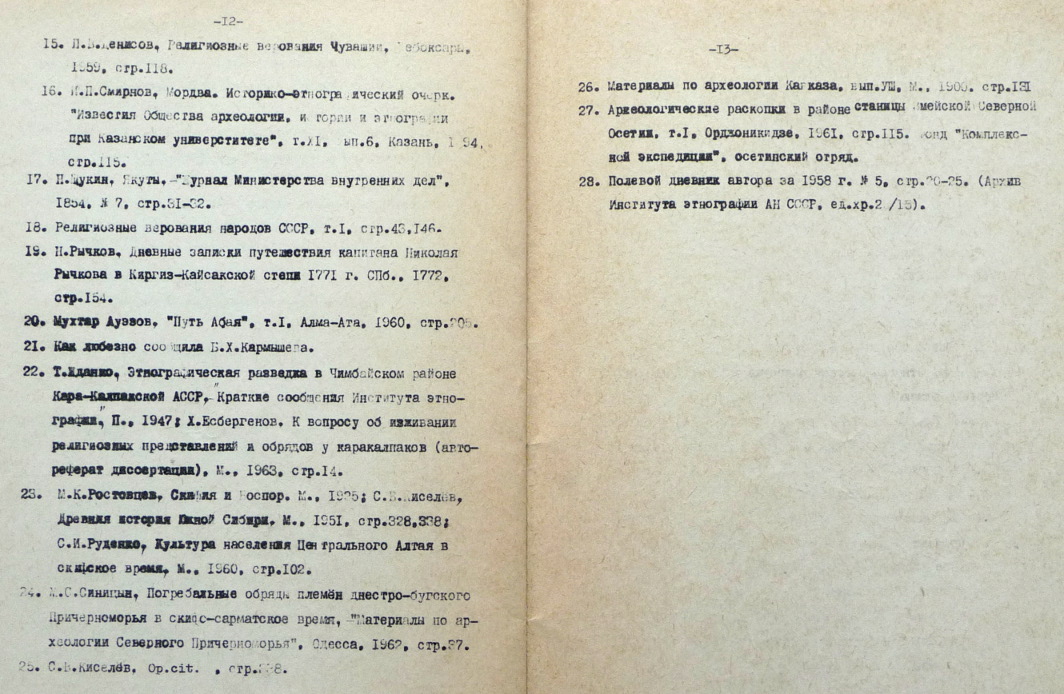'The rite of sacrificing a horse
practised among the Ossets'
BY BORIS ALEKSANDROVICH KALOEV
—
(A very rare paper, originally presented at the VIIth International Congress of
Anthropological and Ethnological Sciences—Moscow, August 1964)
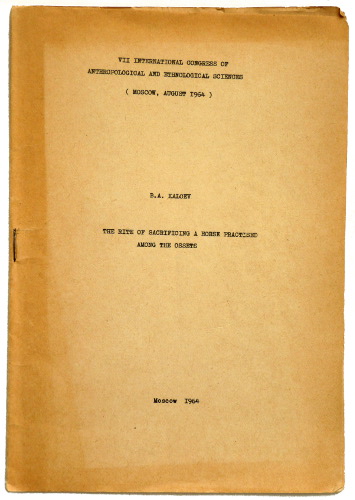
N.B.—The English publication of Kaloev's text in my possession contains many mistakes (grammatical, idiomatic, spelling, typing, &c.), notably the erroneous use of 'initiate' (and all its variables, i.e. 'initiation', 'the initiator', &c.) instead of 'consecrate'. When transcribing the text, I corrected only mistakes such as the latter, which seemed to me to compromise the general sense of the article.
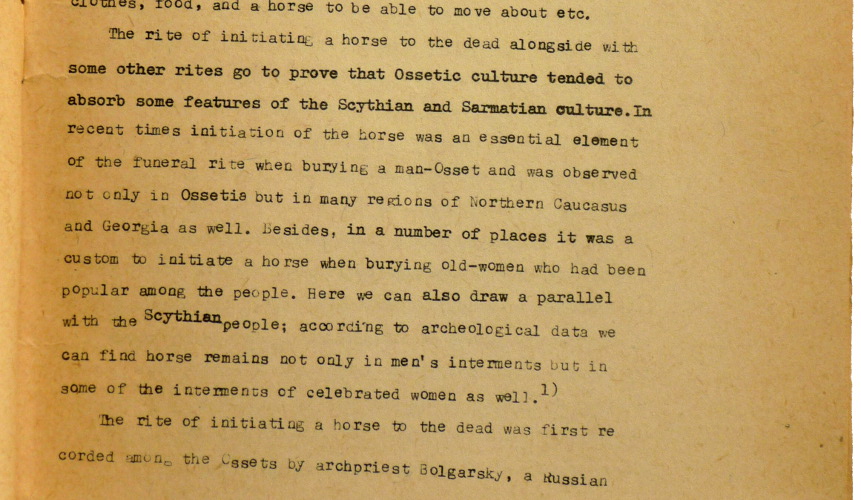
A detail of Kaloev's article
The paper reads:
Funeral rites observed by the people prove to be the most conservative and often preserve many archaic features which can be traced back into ancient times. The same applies to the Ossets as well, who for a long time faithfully observed some ancient funeral rites such as mourning over the dead, numerous expensive funeral feasts, horse-race, cutting of the widow's plait, [consecrating] a horse. The last two rites are known to have been emblematic Scythian ceremonies of sacrificing the wife and a horse to the dead.
These rites were governed by the conception that after passing to the other world the soul of the man will need all the good things the dead had during the life-time. That is why the relatives of the dead did their best to provide him with clothes, food, and a horse to be able to move about etc.
The rite of [consecrating] a horse to the dead alongside with some other rites go to prove that Ossetic culture tended to absorb some features of the Scythian and Sarmatian culture. In recent times [consecration] of the horse was an essential element of the funeral rite when burying a man-Osset and was observed not only in Ossetia but in many regions of Northern Caucasus and Georgia as well. Besides, in a number of places it was a custom to [consecrate] a horse when burying old-women who had been popular among the people. Here we can also draw a parallel with the Scythian people; according to archeological data we can find horse remains not only in men's interments but in some of the interments of celebrated women as well.[1]
The rite of [consecrating] a horse to the dead was first recorded among the Ossets by archpriest Bolgarsky, a Russian missionary from "The Ossetic Ecclesiastical Commission" who was baptizing the mountain dwellers in the mountains of Ossetia during the second half of the XVIII century. This rite has undergone very little changes since the time when it was described by Bolgarsky. Among other things Bolgarsky mentioned that when [consecrating] a horse they would cut off its ear which signified that it was to serve him (the dead) in the other world too.[2]
The rite of [consecrating] a horse is depicted on many grave-stones and on the walls of ancient burial-vaults. Thus on one of grave-stone of the XVI century we can see an old-man-[consecrator] with a horse being [consecrated] (as determined by V.F. Miller).[3]
The horse was decorated before the ceremony. They saddled it and hung up a bashlyk (a hood), hobbles, a felt cloak, and a whip on it; sometimes it was covered with a piece of black satin, and red and blue ribbons were plaited into its mane and tail. Some more archaic features of this rite are still preserved in Southern-Ossetia; here they put almost all the clothes and personal weapon of the dead man on the back of the horse; not long ago this funeral ritual which can be traced back to Scythian-and-Sarmatic and Alanian tribes was observed by the peoples in Pre-Urals regions, in particular by the Kazakhs.[4] Then the dressed up horse was led after the funeral procession to the burial-ground and placed not far from the grave, at the head of the dead. A man, who had some experience in carrying out this rite, and the gift of speech of an orator, approached the animal.
The backfaldishag (which word for word means the [consecrator] of the horse) with the bridle in his left hand and a cup of beer or a horn with araka in his right made a long and beautiful speech which he usually began with the words: 'Oh, almighty God, to-day this man is leaving us to go to the other world, but he needs a good horse. Help him to choose among Terkturk's herds of horses a horse with shoes made of damask steel and fastened with steel nails.... He is leaving for the country of the dead, for the country of Barastir, and he needs a horse that will not stumble when descending and not get tired when ascending.' Then the old man spoke of the good deeds of the dead and of the difficulties he would have to overcome when making his way to the other world. The [consecrator] usually finished his speech with the following words: 'We [consecrate] this horse to you, it will be at your disposal in the other world as it used to be in this. Let the doors of paradise open before you, let the tears of these people help you.' Then the old man poured some drops of araka first on the head of the horse and then on the dead, later on he broke the glass at the shoe of the right foreleg of the animal.
The [consecrator]'s speech was of great interest to the scholars studying the life of the Osset people. It was first published in the Ironian dialect by academian Shifner in the "Proceedings of the Academy of Sciences" of the XIX century.[5] Later V.F. Miller published it in digorian dialect in his "Ossetic sketches".[6] This speech was the fundamental element of the popular poem of "Bakhfaldishag" (the [consecrator] of the horse) by Kosta Khetagurov, the People's poet of Ossetia.[7]
The custom of making a speech (or to read a prayer) when [consecrating] a horse can be traced back to ancient times.
A similar speech or at least some words of a prayer must have been an essential element of the Scythian rite of [consecrating] a horse as a sacrifice. The speech made by the Osset [consecrator] of the horse is to be found in literature; it is a complete work of poetry, which has not originated at once but has been formed gradually for many centuries. Bolgarsky recorded that in the XVIII century in the Ossetic regions which he happened to visit, the speech consisted of some short sentences, pronounced in a whisper, whereas in other regions it could possibly be more complicated in its form and contents even at that time.
The Allans apparently did not break a cup or a jug with the contents but deposited them unbroken with the dead into the grave, and clay jugs discovered in Zmeisk, Alans catacombs can go to prove this fact; archeologists maintain that these jugs must have been filled with a ritual liquid[8], for instance with beer or rong which were the most popular Alan drinks. The Ossets seem to have placed the cups, broken after the prayer-speech of the old man into the grave of the dead too. Then the [consecrator], who was leading the horse by the bridle, the widow and some of close relatives went three times around the dead. After this an end of the horse's right ear was cut off or else a cut was made in it; in many localities they cut off some part of the mane instead of the ear. The ear or the mane that had been cut off were thrown into the grave.
The rite of [consecrating] a horse finished, they cut off the widow's plait. The [consecrator] took the plait and put it onto the breast of the dead saying: 'Here you have also a whip and let you have the two' (i.e. the horse and the wife. B.K.). V.F. Miller was quite right when he pointed out that these ritual is a reflection of the rite of Scythian people to bury the wife (a concubine) and the horse together with the dead.[9] The rite of cutting off the widow's plait and an end of the horse ear seems to have taken place when the Scythian, Sarmat and Alan people were buried. According to archeological data, a horse and the wife (or a concubine) were mainly sacrificed to the dead when clan-and-tribal chiefs or celebrated fighting men were being buried. A.P. Kruglov was the first to record the ancient rite of cutting off a woman's plait, on the basis of the materials collected during the excavations of the Scythian burial mounds in the territory of Chechnya.[10]
The Ossets maintained that the [consecrated] horse belonged only to his master in the other world, and they did not allow it to be [consecrated] for the second time. More than that, they tried to get rid of the [consecrated] horse and take him away from the house lest he cases a misfortune to the family. S.T. Korgin one of the pre-revolutionary authors mentions the fact that when an Osset wanted to buy a horse, he tried to examine 'its helix to make sure that there were no signs of a knife on it, which were characteristic of the horse that had been [consecrated].' An Osset would not buy such a horse as he believed that it was not a horse but its spirit and thought it quite useless for him.[11]
Among other Caucasian peoples the rite of [consecrating] a horse was also considered quite obligatory by the Abkhaz, Svan, Khevsur, Mokheve peoples; the Chechen, Ingush and Adig tribes (the Cabardinsk, Adig and Cherkes peoples) had observed this rite too before they adopted Islam. But some of the main elements of the rite (the speech of the [consecrator], cutting off the widow's plait, and the end of the horse's ear and others) were not included into their ritual ceremony. Their practice was restricted to bringing the saddled horse to be [consecrated] to the corpse lying usually either in the house or in the yard; the horse stood for some time by the dead and then was taken away. The Svans used to place the horse by the hearth opposite the coffin, and take it away after the prayer of the priest was over. When the Mokheves brought the horse to the dead, one of the weepers took the horse by the bridle and began lamenting loudly.[12] The Ingushes and Cabardins, who were close neighbours of the Ossets, observed a rite which in many features reminds us of the Ossetian rite.[13] The Ingush [consecrator] made a short speech and then led the horse three times round the dead. The Abkhaz rite of [consecrating] a horse is very much like that of the Ingush people. The Abkhaz people were not supposed to use the [consecrated] horse or the saddle of the dead for a year.[14]
*
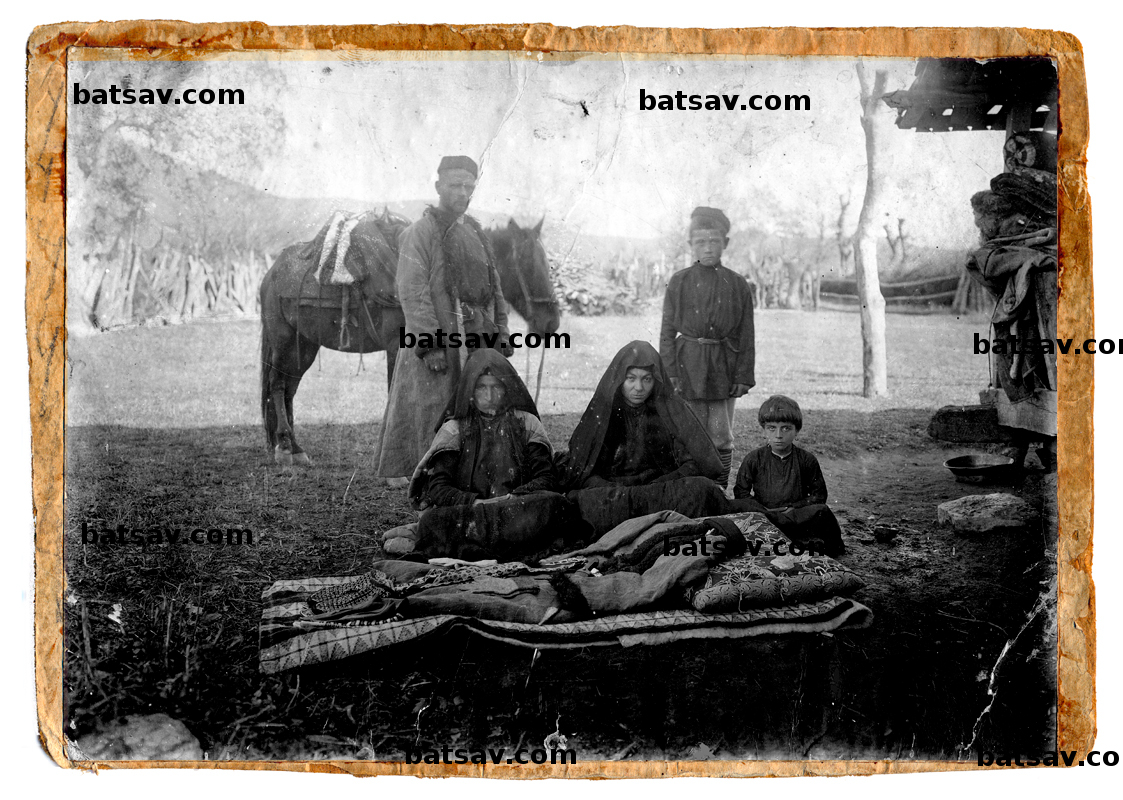
A saddled horse stands ready by the symbolic representation of its deceased owner
(photograph taken in Tusheti among the Tsova-Tush people)
*
The rite of [consecration] of the horse or sacrificing it to the dead was widespread among the people of Povolzhye, Siberia and Central Asia. Thus the Chuvashes of the Yadrinsk district put the horse of the dead into his grave as late as the XIX century.[15] According to Smirnov the Mordovians killed the horse at the funeral feast on the fortieth day after its master's death.[16] The animal was killed at the burial ground and its meat was laid out on the grave of the dead.[16]
Among the peoples of Siberia engaged in cattle breeding the above rite was more often practised by the Yakuts who as late as the XIX century used to bury not only the clothes and food, of the dead, with him, but his saddle-horse too.[17]
The rite of burying the dead together with animals was widely practised by many Northern peoples: the Chukches, Ostyaks, Voguls, Nenzes and others. Almost all the deer-breeders of the North used to kill the dead's favourite deer (or some deers) to bury with him.[18] Among the peoples of Central Asia the rite of sacrificing a horse to the dead was more often observed by the Kazakhs, who had preserved a great number of pre-Islam customs in their every-day-life. The practice of burying the dead with his horse was recorded among the Kazakhs as late as the XIX century. Most Kazakhs, however, replaced this rite by cutting off the end of an ear or a part of the mane and tail. This ritual is observed in exactly the same way as the Ossets used to do it and is practised even by rich cattle-breeders. Thus, M. Auezov describes in his novel The Road of Abai that after the death of a celebrated clan elder-man two of his horses were brought to the door of the yourta (nomad's tent) where the dead was lying; their manes and tails were immediately cut off and they were allowed to join the herds of horses to graze; a year later they were killed at the funeral feast of the dead.[20]
The Uzbek tribes of Karluks and Lokais, who lived in the mountains among the Tajiks, held that the dead when going to the other world should be accompanied by his horse; they usually mourned not only over the dead but over his horse too: the saddled horse, with all the dead man's clothes hanging on it, was tied to a stake in the middle of the yard and the relative walked round the horse and the dead mourning over both; this was done on the second day after the death.[21] Some features of the rite of burying a horse together with the dead are recorded among the Karakalpaks too.[22]
Thus the rite of burying the dead together with his horse, which originated in the Scythian epoch, was observed by some peoples in its original form up to the XIX century, other people preserved this rite in a symbolic form of [consecration]. The fact that this rite fell into disuse among most peoples very long ago is accounted for not only by the influence of Christianity or Islam, who struggled against Pagan religion. To faithfully keep to the ritual, people had to bear expenses which the common people could not always afford. The Scythian burials with a horse, or some horses, are mainly found in the burial mounds of Scythian kings or military leaders. This is, for instance, the case with the Scythian burial mounds of the mountainous Altai.[23] Most of the Scythians, as well as the Sarmats and Alans, confined themselves to burying only some parts of horse-carcass and a harness; but very frequently we find only a harness and no bones of horse in the interment.
Having seized a large territory Scythian and Sarmatian tribes normally exercised a great influence on aboriginals of these lands and some features of their every-day-life and culture were imbibed by the latter. Thus, for example, the rite of burying the dead together with a horse, which had been borrowed from the Scythians, was very frequently observed in the South of the Ukraine, in particular in the Kiev region; it existed up to the IX-X centuries and burials of combatants too can prove this. From here it penetrated to neighbouring peoples, including the Lithuanians. It is worth noting that the burials with a horse are recorded among the Tiurk [sic.] peoples only beginning with the VI century A.D. Thus burials of horses of a modern local breed are discovered in graves of men and women among stone burial mounds dated to the VI-VIII centuries.[25]
It were not only the Scythian and Sarmatian tribes but also the Alanian ones that preserved the rite of burying the dead with a horse in the mountains of Ossetia up to the VIII century and favoured the spreading of the rite among many other peoples, the Tiurks [sic.] included. Burials of horses in a standing position were found in the Alanian katakombs belonging to the same period near the station of Balta on the Voenno-Gruzinskiye highway.[26] No horse-bones were discovered in the Alan burials belonging to the following centuries, there are only harnesses to be found there.[27] Perhaps this may be explained by the fact that the Alan monuments have not been studied well enough.
According to the ethnographic and folklore data, the rite of burying the dead with a horse is supposed to have survived up to the period of Mongolian invasion and in some cases it was observed even after this period. Judging by the information of Mikhail Butaev, an old man of eighty (village of Biz), long ago in a number of places of the Alagirsk ravine in Northern Ossetia there still sometimes buried a horse together with the dead. It is characteristic that bakhfildisag often mentions in his speech that the dead's horse is often sacrificed to him.[28] As it has been already pointed out the Ossets mainly restricted this rite to [consecrating] the horse and cutting off the end of his ear. This rite substituted for the rite of burying the horse with the dead.
The rite of burying the dead with his horse (as well as with his wife) was observed only by clan-and-tribe ruling clique of the Scythian, Sarmats and Alans. Even in ancient times the great mass of population is likely to have kept to the same rites which were still observed by the Ossets not so long ago: cutting off the end of a horse's ear when [consecrating] it to the dead and cutting off the widow's plait. It cannot be doubted that a number of features of the Scythian-and-Sarmat culture were borrowed by the Ossets: other people, who observed the rite in question may also have borrowed it from Scythians-and-Sarmats.
Kaloev's notes (click for larger view):
A bit of Herodotus on the side
It is often said that the Ossetians adopted the custom of involving horses in burials from the Scythians. Here is Herodotus's description of a royal Scythian burial in all its gory detail:
The tombs of their kings are in the land of the Gerrhi, who dwell at the point where the Borysthenes is first navigable. Here, when the king dies, they dig a grave, which is square in shape, and of great size. When it is ready, they take the king's corpse, and, having opened the belly, and cleaned out the inside, fill the cavity with a preparation of chopped galingale[*], frankincense, parsley-seed, and anise-seed, after which they sew up the opening, enclose the body in wax, and placing it on a waggon, carry it about through all the different tribes. On this procession each tribe, when it receives the corpse, imitates the example which is first set by the Royal Scythians; every man chops off a piece of his ear, crops his hair close, and makes a cut all round his arm, lacerates his forehead and his nose, and thrusts and arrow through his left hand. Then they who have the care of the corpse carry it with them to another of the tribes which are under the Scythian rule, followed by those whom they first visited. On completing the circuit of all the tribes under their sway, they find themselves in the country of the Gerrhi, who are the most remote of all, and so they come to the tombs of the kings. There the body of the dead king is laid in the grave prepared for it, stretched upon a mattress; spears are fixed in the ground on either side of the corpse, and beams stretched across above it, and the whole covered with a roof of twigs. In the open space around the body of the king they bury one of his concubines, first killing her by strangling, and also his cup-bearer, his cook, his groom, his lacquey, his messenger, some of his horses, firstlings of all his other possessions, and some golden cups; for they use neither silver nor bronze. After this they set to work, and raise a vast mound above the grave, all of them vying with each other and seeking to make it as tall as possible.
When a year is gone by, further ceremonies take place. Fifty of the best of the late king's attendants are taken, all native Scythians—for as bought slaves are unknown in the country, the Scythian kings choose any of their subjects that they like, to wait on them—fifty of these are taken and strangled, with fifty of the finest horses. When they are dead, their bowels are taken out, and the cavity cleaned, filled full of chaff, and straightaway sewn up again. This done, a number of posts are driven into the ground, in sets of two pairs each, and on every pair half the felly of a wheel is placed archwise; then strong stakes are run lengthways through the bodies of the horses from tail to neck, and they are mounted up upon the fellies, so that the felly in front supports the shoulders of the horse, while that behind sustains the belly and quarters, the legs dangling in mid-air; each horse is furnished with a bit and bridle, which latter is stretched out in front of the horse, and fastened to a peg. The fifty strangled youths are then mounted severally on the fifty horses. To effect this, a second stake is passed through their bodies along the course of the spine to the neck; the lower end of which projects from the body, and is fixed into a socket, made in the stake that runs lengthwise down the horse. The fifty riders being thus ranged in a circle round the tomb, the Scythians ride away.
Herodotus, The History of Herodotus of Halicarnassus, Book IV, Ch. 71-72, C. Rawlinson's translation, revised and annotated by A. W. Lawrence—quoted in Karl Jettmar's Art of the Steppes: The Eurasian Animal Style (London: Methuen, 1964, pp. 28-30).
Unless stated otherwise or obviously not the case, all materials on this website are © A.J.T.Bainbridge 2006-2013
Get in touch! Gmail: alexjtb

